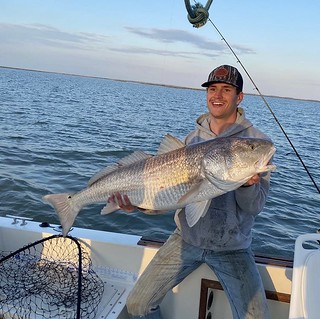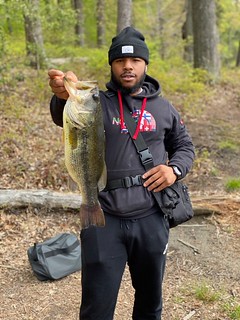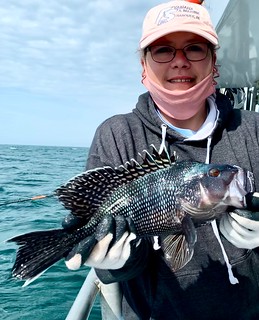Maryland Fishing Report – May 20

Braden Walsh is all smiles with the first golden trout that he caught last weekend. Photo by Gary Soukup
It may be hard to believe, but Memorial Day weekend approaches. Folks are seeking rejuvenation in the outdoors, which is encouraged as long as we’re being safe and considerate in regard to social distancing.
As we all start spending more time on the water, a reminder that our biologists have instituted several volunteer angler surveys to help them understand and better manage some of the important fish species to anglers as well as blue crabs and horseshoe crabs.
The Maryland Department of Natural Resources is working to help the public navigate through these trying times, and our website will continue offering guidance on a variety of outdoor activities.
Forecast Summary: May 20-26:
Cool conditions continue as we head towards the Memorial Day weekend, but warming temperatures are just around the corner. Main bay water temperatures have warmed slightly since last week. Bay surface water temperatures have risen to the upper 50s and will continue rising into next week. Due to limited rainfall, many of the streams and rivers are running warmer, up to the low 60s,
The Maryland portion of the bay continues to have suitable oxygen conditions from surface to bottom. Expect reduced water clarity in the upper bay from the Susquehanna Flats area down to near Back River and on the Potomac River downstream to near Colonial Beach. In addition, expect poorer-than-normal water clarity on the western shore from the Bay Bridge down to below Chesapeake Beach due to recent algae blooms. Expect normal flows all week from most of Maryland’s rivers and streams. There will be above average tidal currents all week as a result of the new moon May 22.
For more detailed and up-to-date fishing conditions in your area of the bay, be sure to check out Click Before You Cast. Get regular updates on Maryland’s waters sent to your inbox with our Eyes on the Bay newsletter. Sign up online.
The lower Susquehanna River and surrounding waters are beginning to clear up from stained conditions that prevailed earlier, and water temperatures are holding around 62 degrees. Fisherman’s Park is now open near the Conowingo Dam, where anglers can fish for a mix of flathead, blue, and channel catfish. Fishing for striped bass above the Lapidum-Twin Rocks-Tomes Wharf boundary line will be closed until June 1.
White perch are filtering into the lower Susquehanna River. Fishing for striped bass below the Lapidum-Twin Rocks-Tomes Wharf boundary line south to a line drawn from Turkey Point to Sandy Point is now open with a one fish per day creel limit and a legal slot size of 19 inches to 26 inches. Windy conditions have hampered fishing from small boats recently but there should be striped bass holding near channel edges. Casting soft plastic jigs and rattle trap lures usually work well. The latest striped bass regulations can be found on the DNR website. The area from the Turkey Point-Sandy Point line south to a line drawn from Abbey Point to Worton Point is closed to all striped bass fishing.
Fishing for blue catfish and channel catfish below the railroad bridge on the lower Susquehanna and the nearby Elk and other rivers in the upper bay continues to productive. Cut bait, chicken liver, and a variety of other favored baits work well. White perch fishing in the upper bay tributaries is good and can be caught in deeper waters on grass shrimp or pieces of bloodworm and by casting small lures in shallow areas.
Boats have been anchoring up on the steep channel edge at Podickory Point and the Sewer Pipe, chumming for striped bass this week. Catches of striped bass have been slow but the chum slicks are attracting large numbers of catfish, which are keeping anglers busy. Trolling a mixed spread of lures for smaller striped bass and the big stuff for trophy-sized fish has been a slow pick at best at the shipping channel edges in the upper bay, Podickory Point, and the Dumping Grounds have seen the most action this week.
Check the department’s website for the current striped bass map outlining areas open to fishing, catch and release only and those closed to striped bass fishing.

Paul Callahan was trolling along the western edge of the shipping channel recently when he caught this striped bass of a lifetime that came within 3.5 pounds of breaking the existing 67.5-pound state record striped bass. Photo courtesy of Paul Callahan
This region is offering some of the best opportunities to catch a trophy striped bass. The west side of the shipping channel from the Parkers Creek area north past Breezy Point, Chesapeake Beach, and past Thomas Point to Hacketts Point have been excellent places to troll for striped bass. The east side of the shipping channel from the Brick House Bar to Bloody Point, south past Buoy 83 to the CP Buoy should not be overlooked.
Trolling spreads of large parachutes and bucktails dressed with equally large sassy shads rigged in tandem behind planer boards are popular as always. Umbrella rigs with parachute or bucktail trailers have also been part of most trolling spreads, and medium-sized lures are mixed in for smaller striped bass.
White perch are providing plenty of fun and rewarding fishing in the tidal rivers and creeks of the middle bay. They can now be found near docks and piers, breakwaters at harbor entrances, fallen treetops, and similar shoreline structure. When fishing near docks and piers, a small sinker, a single hook, and a piece of bloodworm or a grass shrimp is hard to beat when fished tight to the dock or pier. Casting small spinners, curly tail jigs, spinnerbaits, or small rattle trap lures near shoreline structure can offer lots of fun light-tackle action.
Several species of catfish can be found in the tidal rivers of the middle bay. Blue catfish can be found in the Dover Bridge area of the Choptank River, and channel catfish are spread throughout the river down to the Bill Burton Fishing Pier. Channel catfish can also be found in good numbers in the Miles and Wye rivers as well as all the tidal rivers on the western side of the bay.
Fishing for northern snakeheads in the Dorchester County tidal waters continues to be very good, despite the fish beginning to enter their pre-spawn mode of behavior. A large minnow tethered under a bobber is still hard to beat, but casting topwater lures back into shallower grassy areas is paying off in a big way.

Hunter Smith holds up this 47-inch red drum he caught and released in Tangier Sound. Photo courtesy of Hunter Smith
Trolling for large trophy striped bass continues to be the main focus of most fishermen out in the bay, along the steep shipping channel edges from Parkers Creek down past Cove Point and Point Lookout. Large bucktails and parachutes dressed with large sassy shads and rigged in tandem have been popular and white has been a favorite color. Umbrella rigs are also part of most trolling spreads and often set up with bucktails or hose lures as trailers.
The steep channel edge in front of St. George’s Island in the lower Potomac River is also a location that is getting a lot of attention. Potomac River regulations concerning striped bass can be found on the Potomac River Fisheries Commission website.
Those fishing around Tangier and Pocomoke sounds are enjoying fun and productive shallow-water fishing for striped bass and speckled trout. Most are casting soft plastic swim baits and jerkbaits. A surprising number of flounder are showing up near the channel edges and flats in Pocomoke Sound this week. Those who are trolling around the Target Ship and eastern channel edges are finding the occasional large striped bass and also large red drum — the latter are far beyond the slot size and must be released, but provide a real thrill.
Fishing for blue catfish continues to attract a lot of anglers to the tidal Potomac River from the Wilson Bridge down to the Bushwood area at the mouth of the Wicomico River. Most all who fish for them are easily catching as many as they need. Fresh cut bait remains the preferred bait. On the Eastern Shore, the Nanticoke River in the Sharptown-Marshyhope area is productive to fish for blue catfish, and they are becoming more common in the Wicomico and Pocomoke rivers.
Anglers at Deep Creek Lake report that the walleye are biting well in the evenings on a variety of lures, but jerkbaits tend to top the list. Retrieving and then pausing seems to get the most strikes. Smallmouth bass are starting to be found in the spawning areas close to shore and aggressive males are striking a variety of lures.
Smallmouth bass fishing on the upper Potomac River is good and they can often be found slightly downstream of spawning carp, which are chasing baitfish and crayfish from shallow areas where they are stirring things up. Another place to look for smallmouth bass is near spawning areas and shoreline grass areas early in the mornings. Look for large, calm eddies behind shoreline points, island cuts, emerging grass beds. Keep in mind there is a closed season on largemouth and smallmouth bass until June 15, so catch and release only.
Those who are fly fishing in the special trout management waters of Western Maryland are finding good water flows and excellent fishing opportunities. The prolific caddis hatches are starting in the Youghiogheny River catch-and-release trout fishing area. The hatches tend to pick up later in the day. Many of the browns and rainbows are taking the green emerger caddis tied on below the #14 Elk-Hair Caddis.
This is a wonderful time of the year to flex those lightweight fly rods and head to your favorite pond to fish for bluegills. Small rubber-legged poppers and ants will often drive bluegills into some exciting topwater action and really put a bend in that fly rod. Crappie are also fun to catch on a fly rod with a sinking tip line and small streamers and deer hair Mickey Fin type flies. Sinking marabou flies are also proven crappie killers.
Put-and-take trout stocking is now over for the spring season but anglers are still finding trout to catch in those areas. Casting small spinners and gold spoons is a great way to cover a lot of water when looking for those trout that have evaded the temptation of Powerbait dough balls. The delayed harvest trout management areas will be open June 1 up for a 5-fish daily possession limit with no tackle restrictions.
Anglers have been targeting largemouth bass from our largest tidal rivers and reservoirs to farm ponds across Maryland this week. In most areas largemouth bass are holding near grass and shallow structure. Largemouth bass, especially the females, are aggressively feeding after spawning activity building up lost body reserves. Casting topwater lures over grass or dropping soft plastic down through thicker and deeper grass is always a proven tactic. Working jerkbaits, spinnerbaits, and crankbaits along the outside edges of grass or sunken structure in transition zones is another productive way to fish. In the tidal rivers and larger creeks, small feeder creeks are a good place to target as are the outside edges of grass beds and spatterdock fields on a falling tide.
Liberty, Prettyboy and Loch Raven reservoirs, managed by Baltimore City, are now open to fishing from permitted boats and shorelines. Fishing platforms remain closed. Triadelphia Reservoir is also now open to fishing.
Crappie fishing is good as they are schooled up near structure and can be caught on small minnows under a bobber or a marabou jig rigged the same way. In tidal waters, marina docks are a favored place target. Fallen treetops and sunken wood are other good places to look for crappie.
Surf casters have had a difficult time with strong easterly winds and heavy surf. The Memorial Day weekend looks promising and may offer a relaxing time to soak baits. A few bluefish are moving along the coast; the northward migration of large striped bass is on its way and of course skates will keep anglers busy.
Those strong easterly winds have the back bay areas stirred up, making for fair to poor flounder fishing. The flounder are there and as soon as the waters clear up, good fishing should begin again. This will be a busy weekend so be careful when fishing in the channels and lookout for heavy boat traffic. Striped bass that mostly miss the 28-inch mark are being caught near the inlet and the Route 90 Bridge on swimshads and small bucktails.
There are excellent numbers of sea bass waiting for anglers out at the offshore wreck and reef sites and as soon as the ocean calms down, party and charter boats will be taking anglers out. Last weekend a few charter boats that headed south to distant offshore waters came back with yellowfin tuna and at least one swordfish has been brought to the docks of Ocean City.
As a reminder: Any harvested bluefin tuna, billfish, swordfish, or shark (except spiny dogfish) must be reported via the Catch Card Census before it is moved from a boat, or point of landing if fishing from shore, to be in compliance with state and federal regulations. Catch cards and tags are available at tackle shops, marinas and kiosks around Ocean City, and online. Please use the kiosk at the Colonel Jack Taylor Boathouse located in west Ocean City when businesses are closed. Simply fill out the card found in the kiosk and tear off the receipt on the edge of the card, and leave the card in the kiosk. Identification and compliance information is available from the National Oceanic and Atmospheric Administration.
Dusky and sandbar sharks look similar and both sharks are prohibited from harvest. If you cannot identify the shark, let it go in the water. State and federal regulations require shark anglers to use corrodible, non-stainless circle hooks except when fishing with artificial flies and lures, and any shark that is not being kept is to be released in the water. Anglers must have a device capable of quickly cutting either the leader or the hook. Identification and compliance information is available from the National Oceanic and Atmospheric Administration.
“We cannot direct the wind, but we can adjust our sails.” — Thomas S. Monson
Maryland Fishing Report is written and compiled by Keith Lockwood, Maryland Department of Natural Resources fisheries biologist.
Click Before You Cast is written by Tidewater Ecosystem Assessment Director Tom Parham.
This report is now available on your Amazon Echo device — just ask Alexa to “open Maryland Fishing Report.”



 1-888-373-7888
1-888-373-7888 233733
233733